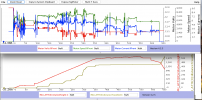It's always been that way, 500m is the default DJI max altitude, although it can change depending on where you are, like the recent 120m limit on the
Mini 4 in Europe. In general the legal limit worldwide is 120m above ground, measured from the drone, and you have that +/-500m margin on the app in case you fly in mountain areas.
You can hack some DJI drones to bypass this limitation, for example the
Mini 2 is fully hackable (FCC mode, no geofencing and no altitude limit) even on its latest firmware. And of course, I climbed to its max altitude (limited by the battery), which is around 1.600m. It has enough juice to go up a bit more, but the battery safety kicks with 60% left or so and enters forced landing mode. It doesn't take into calculation that descending is basically free, as you have a ton of potential energy.
When it enters forced landing mode it also makes the drone slower, so you can have a flyaway easily if there is some wind.
I have to ask again because I'm not so sure I got the answer the last time:
Often we see reports of drones being seen at 12,000 feet and I didn't think it was possible except if a drone got carried away, got loose and there was a flyaway. Ok but my question is if you set the max height to 500 feet and your drone malfunctions and experiences a flyway, is that 500 feet limit in the drone itself (now disconnected from the controller) such that even with a good GPS signal, your drone won't go any higher than 500 feet as it flies off into the heavens?
If you can get to 1.600m with a
Mini 2... if you can hack a
Mavic 3, which climbs twice as fast and has more than double the flight time... yes, you can reach that altitude within the battery limits. As for being seen at that altitude... that's completely false. Most "drone" sights at high altitude are balloons (DIY satellite/atmospheric hobbyist and students). While you are flying a plane, you can't see a tiny <900g drone flying around unless it's already hitting your windshield.
DIY drones can also climb that high as they have no babysitting software, the thing is temperature descends at around 6.5ºC every 1.000m, so if you are at 25ºC at ground level, it's dangerous to go past 3.800m or so, as frost can quickly build up on the props (specially inside a cloud), and it will basically fall at its terminal velocity to the ground, which is not a desirable scenario.
Apart from testing purposes, there's usually no interest in going above the 500m limit, and usually, 120m is just fine for most photos/videos.
If you want to fly high and stay legal, just search for a mountain nearby, climb it and take off from there. Then you'll have the mountain altitude + 120m. Which is basically what you had to do in the past for landscape photography... unless you were millionaire and had a copter.













